A Digital Twin on CAR-T Cytokine Release Syndrome (CRS) Patients with Standard of Care Measured by CRS Distribution by Grade
Using existing clinical trial data to proactively model patient safety and efficacy outcomes could aid in accelerating development for areas in need of new therapies.
In recent years, scarcity of available patients for clinical research into certain diseases has driven a move toward leveraging digital resources to supplement clinical trial data. One such disease is Cytokine Release Syndrome (CRS), a systemic inflammatory response caused by cytokines released by infused CAR-T cells. Although CRS is a relatively rare indication, CRS-related mortality associated with CD19 CAR-T cell therapy is 5.4%. As CAR-T cell therapy becomes more widely used, new therapies to target CRS are needed.
A digital twin was constructed using data from 5,473 CAR-T treated patients: 5,335 in a cohort setting and 138 with individual records. The CRS by Grade showed consistency across the eight cohorts of data. Specifically, Grade 4 CRS ranges between 0 and 8%, with 2% in total. Grade 3 CRS ranges between 0 and 20%, with 5% in total. Grade 2 CRS ranges between 26% and 71%, with 44% in total. Grade 1 CRS ranges between 10% and 71% with 34% in total. Grade 0 CRS ranges between 0% and 40% with 16% in total.
We predict with a high level of confidence that our conclusion will be validated by actual single or multiple arm clinical trials on CRS following CAR-T cell treatment. If discussed early in the clinical trial lifecycle, this approach could be accepted by regulatory authorities as a digital trial arm.
Background
It is not a novel concept to use patient data obtained from sources in clinical development, other than randomized clinical trials, to generate digital patient profiles, define the target label and design studies. In recent years there has been renewed and intensified efforts to rethink the approaches employed by the clinical development industry to reduce patientsand investigator site burden and the time and cost of licensing new products.1 The rarity of available patients for research into certain diseases, and the ethical challenges in committing gravely ill patients to placebo or inferior comparators, has further driven regulators and sponsors to rethink the drug development approach.
Pooling individual patient data from parties owning the data is one method currently being explored by sponsors. However, the challenge has been in finding enough parties willing to share sufficient relevant data to reach statistically meaningful power. Patient records held by hospitals can be used to supplement the data held by the clinical development industry, however finding enough qualified patient data through ethically sound processes and in a timely manner, has proven to be a significant challenge.
Made possible by growing and cost-effective computing capacity, artificial intelligence (AI) enables the building and analysis of databases with unprecedented scale and speed. With the clinical development industry’s access to a growing volume of data, the management and processing of data using AI is another area of significant interest. Since 2006 and over 15 years, Phesi has built a global database of contextualized patient data from more than 480,000 curated trials and more than 60 million patients. To populate this database, data were collected from approximately 500,000 patients each year, using sources including Phase I-IV clinical trials and observational clinical studies, disease registries, retrospective chart analyses and case studies (Figure 1). Despite the large volume of patients involved, this database includes detailed contextual patient data, including when the data were collected, by whom, inclusion and exclusion criteria, and other relevant factors.
Figure 1. Data added to Phesi database from patients in clinical trials
Source: Phesi
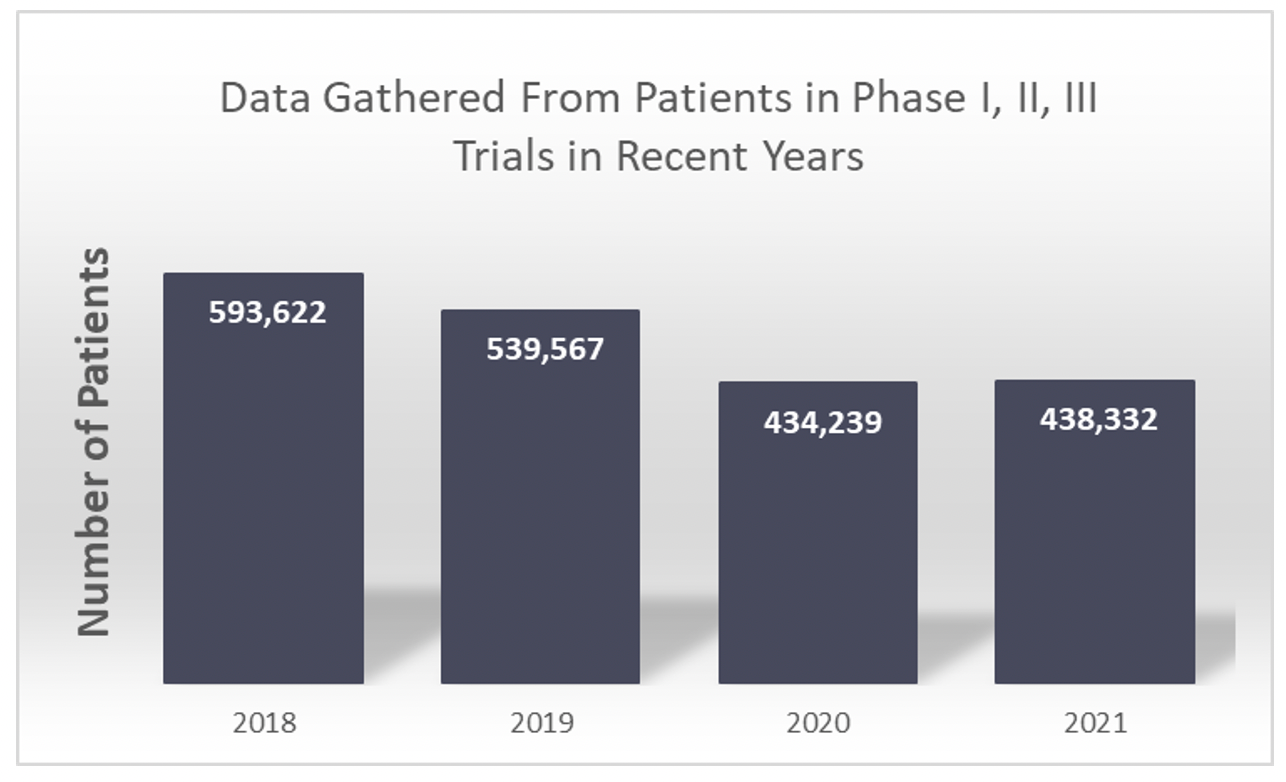
Once in this database, patient data can be assessed at either an individual patient level or a cohort level. A patient cohort contains summary statistics for a group of patients with shared characteristics collected from one or more institutions, by a single or multiple investigators and in one or multiple countries. Examples of cohorts are clinical trial arms, a group of patients from a subgroup analysis, or a patient population in a retrospective analysis sanctioned by one or more institutions. AI is then used to extract and tabulate patient data, not to interpret patient data.
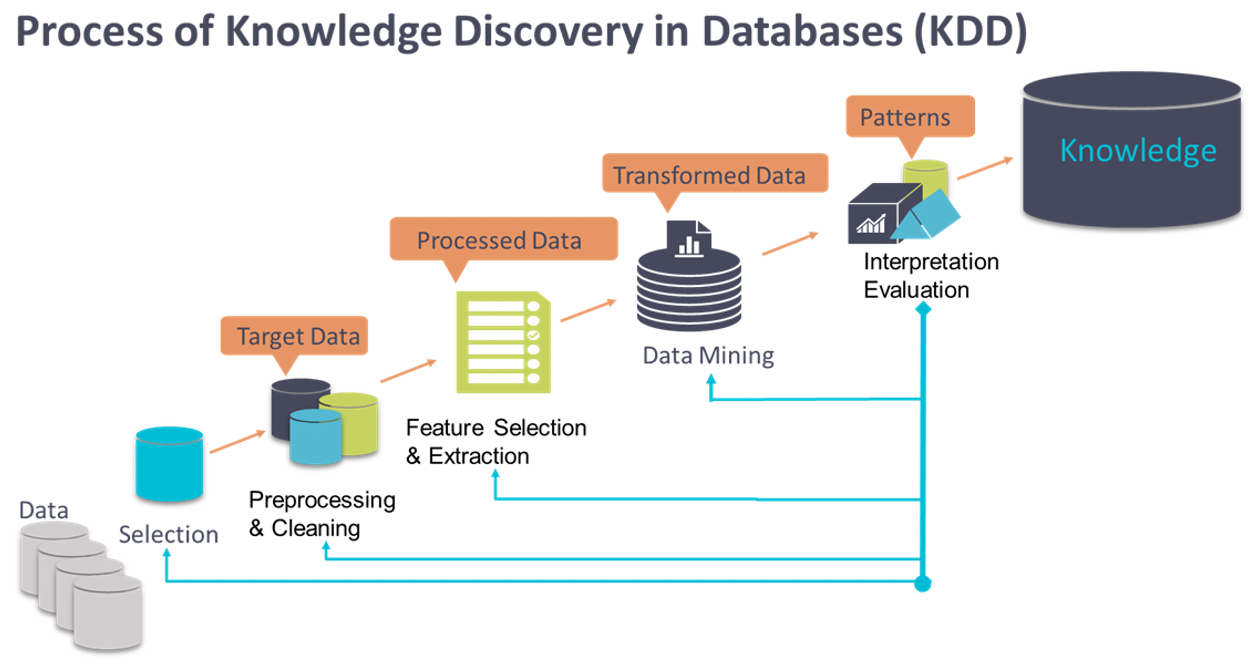
The method of using AI to extract and tabulate patient and other clinical development related data is the subject of a separate article.2
The available data has a multitude of use cases to streamline the clinical development process, including the construction of digital twins or digital trial arms. A digital twin is defined as a virtual model designed to accurately reflect the safety and efficacy parameters and a digital trial arm, defined as a type of external control that is generated using external patient-level data to improve the interpretation of uncontrolled trials.
Digital twins and digital trial arms both significantly reduce patient and investigator burden by reducing the need for control groups and can inform the design of clinical trials in rare or severe diseases. As shown previously,2 we do not need to restrict patient data sources to randomized controlled clinical trials when constructing digital twins or a digital trial arm. A digital trial arm based on a digital patient profile can be used to replace a real-world clinical trial arm in regulatory submissions and approval. (Figure 2).
Figure 2. Key clinical development benefits delivered by data science
Source: Phesi
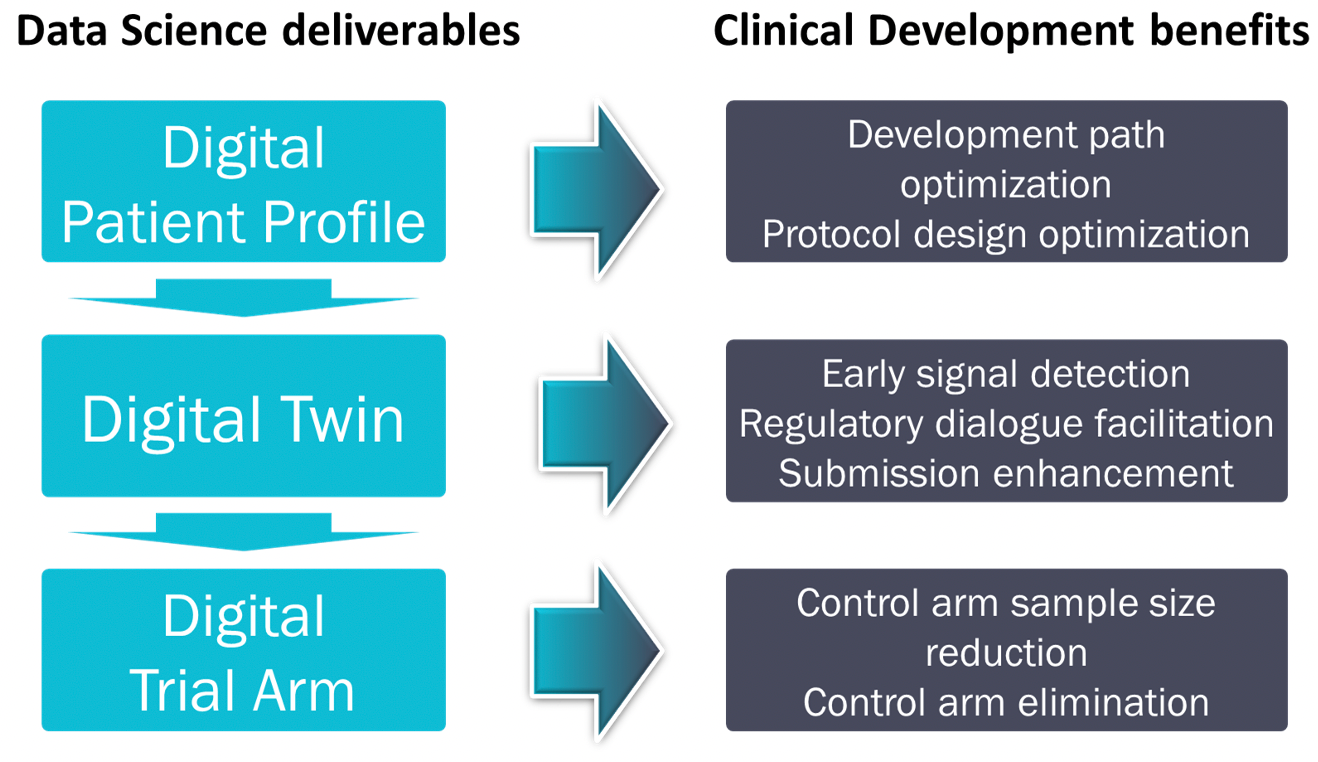
Cytokine Release Syndrome (CRS), a systemic inflammatory response caused by cytokines released by infused CAR-T cells, can lead to widespread organ dysfunction.3 CRS is a very serious complication of immunotherapies and viral infections, such as SARS-CoV-2. CRS-associated mortality associated with CD19 CAR-T cell therapy is 5.4%.4 The per patient total cost of treatment with CAR-T therapy, such as tisagenlecleucel, ranges from $478, 777 for those patients without CRS to $531, 823 for those with severe CRS (CRS Grade ≥3).5
Tocilizumab was approved by FDA in August 2017 to treat CRS occurring after CAR-T infusion.6 New, and more effective treatment of Grade 2 or higher CRS is needed. CRS patients following CAR-T cell infusion are uncommon; they could almost be considered as “rare disease” patients. Because of the scarcity combined with the need for new therapies, a digital twin for this population would be a valuable resource for use in clinical development, and should be considered for regulatory approval as a digital trial arm.
In this article, we describe the digital twin of efficacy outcomes for CAR-T CRS patients with Standard of Care (SoC), assessed by CRS distribution by Grade.
Methods
To construct a digital patient profile, data from the Phesi database was used to identify key patient attributes such as demographics, concomitant medication, comorbidities, disease status and outcomes, for CRS SoC. When inclusion and exclusion criteria were applied to the target patient population, this digital patient profile becomes a digital twin, to represent baseline patient characteristics. Next, primary outcome measure(s) of the baseline patient population were tracked and aligned with planned clinical trial design, with the same treatment duration and other defined criteria. With this approach, a digital twin for the CRS patient population was developed based on primary efficacy outcome(s). Similarly, this approach can be applied to construct a digital twin of the safety outcome(s) for patients in the control arm of the planned clinical trial.
A digital twin was constructed using data from 5,473 CAR-T treated patients: 5,335 in a cohort setting and 138 with individual records. Data were gathered from existing digital sources, including anonymized patient data from clinical trial participant records. While statistical outliers possibly exist, conclusions were drawn from multiple and diverse data sources to minimize their impact.
We identified patients who met specific inclusion/exclusion criteria. The analysis included patients aged 18 years or older with lymphoma who were eligible for CAR-T cell infusion and had previously experienced at least one line of treatment. Patients had an Eastern Cooperative Oncology Group (ECOG) performance status of 0–2. CRS grading was generally based on American Society for Transplantation and Cellular Therapy (ASTCT) Consensus criteria.7 These criteria are consistent with those described in source documents and can be verified accordingly.8-14
By applying these inclusion/exclusion criteria, a total of 392 patients from eight patient cohorts were derived for the construction of this digital twin of CRS SoC measured by CRS grade (Figure 3).
Figure 3. Cohort selection for CRS SoC digital twin
Source: Phesi
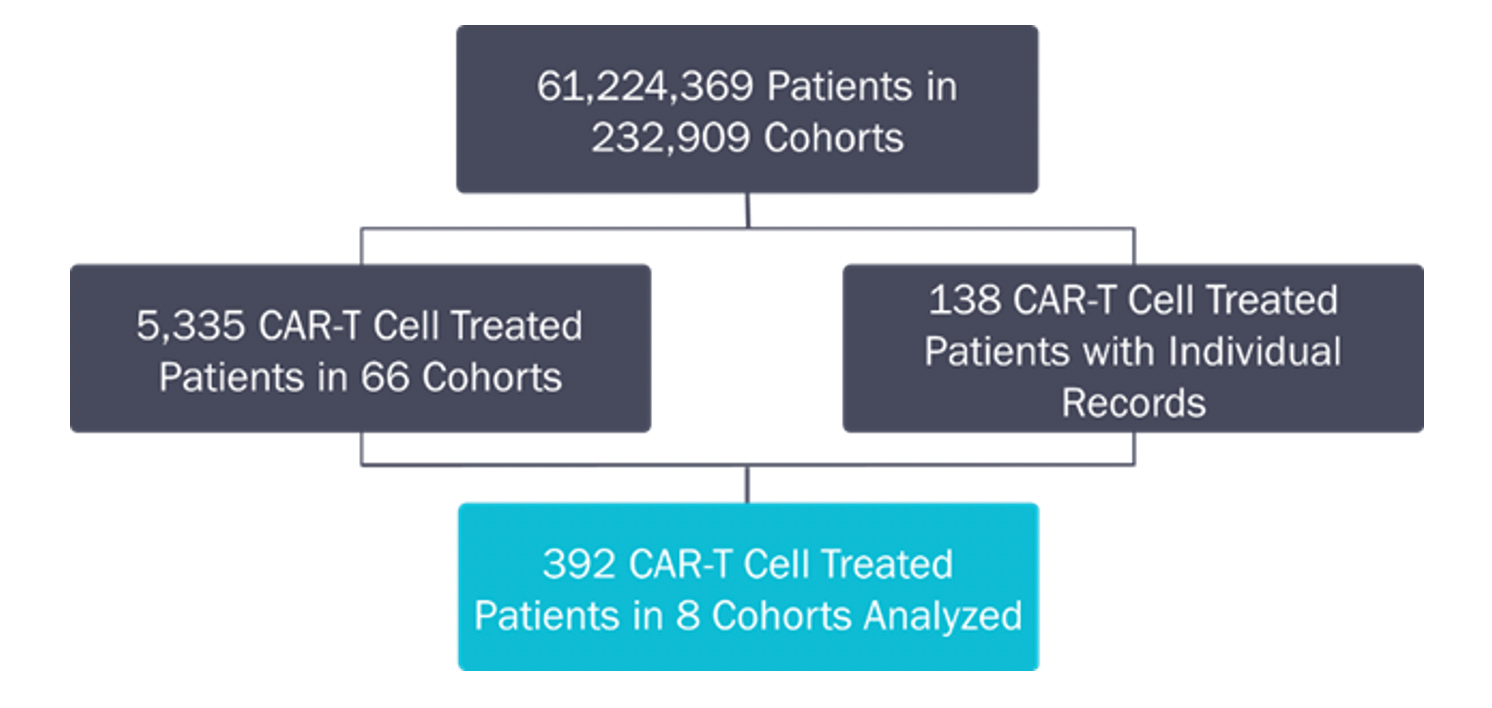
Not only did these 392 patients meet the pre-defined inclusion/exclusion criteria, but documented data on each individual CRS Grade was also available. For example, if the CRS data were provided by combining CRS Grade 1 and Grade 2, the data cannot be fit for the construction of this digital twin. This is one of the reasons why only 392 of the 5,335 baseline patient population were used for digital twin construction. In other cases, there was no CRS data available in source documents within the Phesi database.
Results
With baseline data from 5,473 patients, we constructed a digital twin of the baseline patient.
Table 1. A digital twin of the CAR-T CRS patient treated by SoC
Source: Phesi
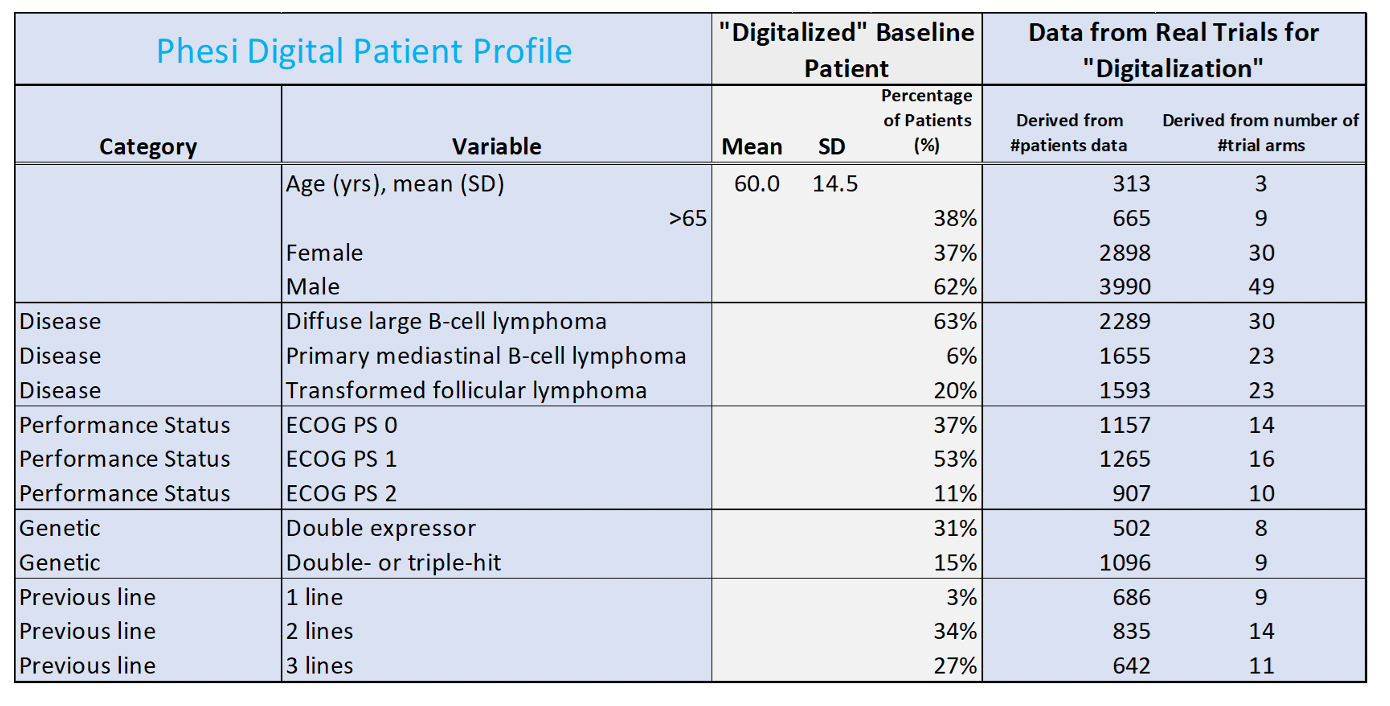
From the 5,473 CAR-T cell-treated patients which met the predefined inclusion and exclusion criteria, a total of 392 patients with CRS data were documented at each individual CRS Grade level (Figure 4). The 392 patients were from eight centers in the USA and Europe. All patients analyzed were recruited and treated between February 2016 and January 2020.3-9
Figure 4. Percentage of CAR-T cell-treated patients with CRS by disease Grade
Source: Phesi
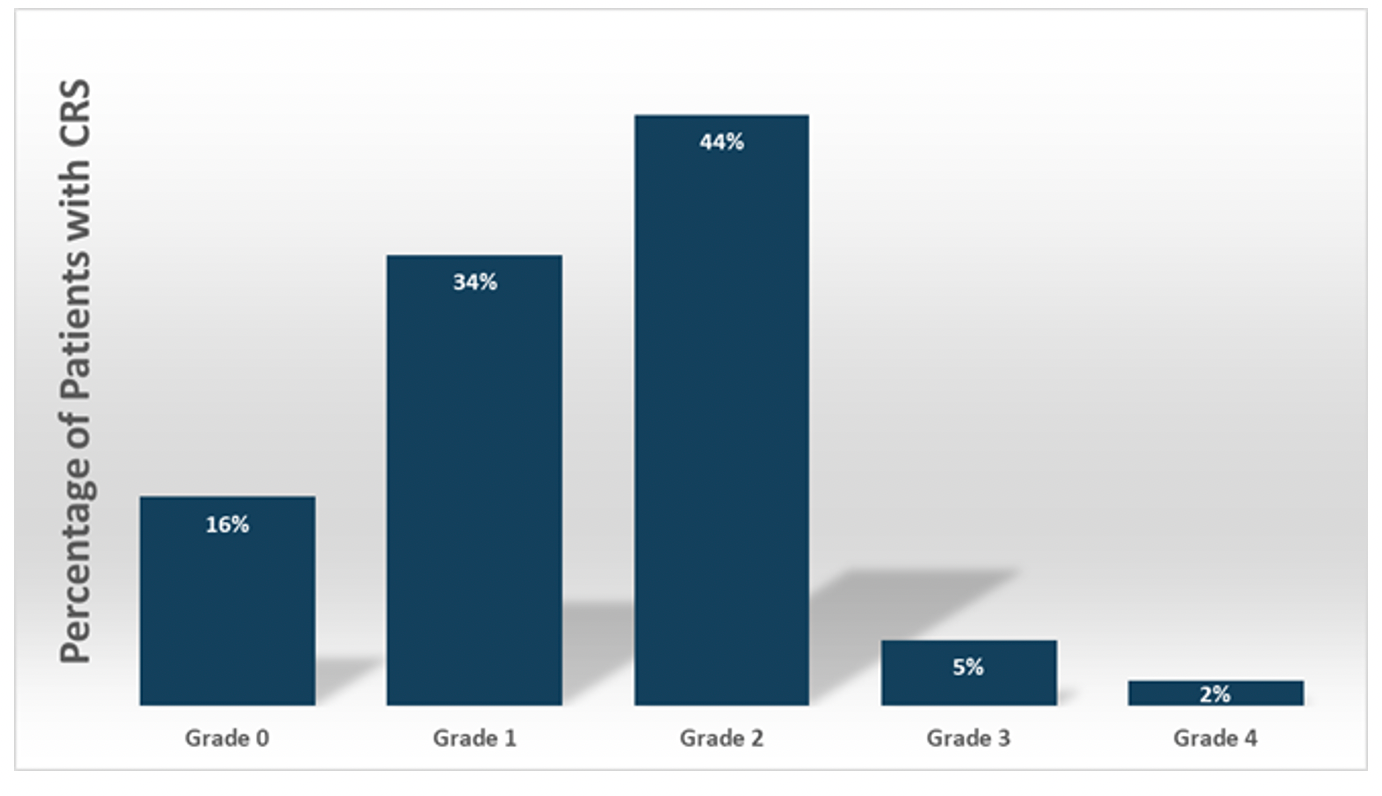
Table 2. Aggregated distribution of CRS by Grade analysis supported by data from individual cohorts3-9
Source: Phesi

In summary, the CRS by Grade showed consistency across the eight cohorts of data (Figure 5). Specifically, Grade 4 CRS ranges between 0 and 8%, with 2% in total. Grade 3 CRS ranges between 0 and 20%, with 5% in total. Grade 2 CRS ranges between 26% and 71%, with 44% in total. Grade 1 CRS ranges between 10% and 71% with 34% in total. Grade 0 CRS ranges between 0% and 40% with 16% in total.
The variance is introduced by different causes. For instance, the sample size is dependent on the composition and stage of diseases, and previous and current medical treatment(s). The inconsistency is reflected by the low percentage (7%) of high-Grade CRS (Grade 3 and 4), and the high percentage (44%) of the median Grade CRS (Grade 2). A more effective treatment of CAR-T related CRS should be able to suppress high-Grade CRS, and significantly reduce median Grade CRS. Similar to this digital twin, a digital trial arm should show similar CRS-by-Grade distribution pattern.
Figure 5. CRS across grades across the 8 cohorts
Source: Phesi

Discussion
Today's drug development and clinical trial approach is based on gathering data from individual patients, usually in a randomized, double blind, placebo-controlled setting. In constructing the CAR-T CRS digital twin, we used a combination of cohort data and data from individual patients. Specifically, Cohort H,7 Cohort I,8 and Cohort J,9 are from individual patient data. Table 3 shows individual patient data as an example:
Table 3. An example of the individual patient data used to construct the CAR-T CRS digital twin
Source: Phesi
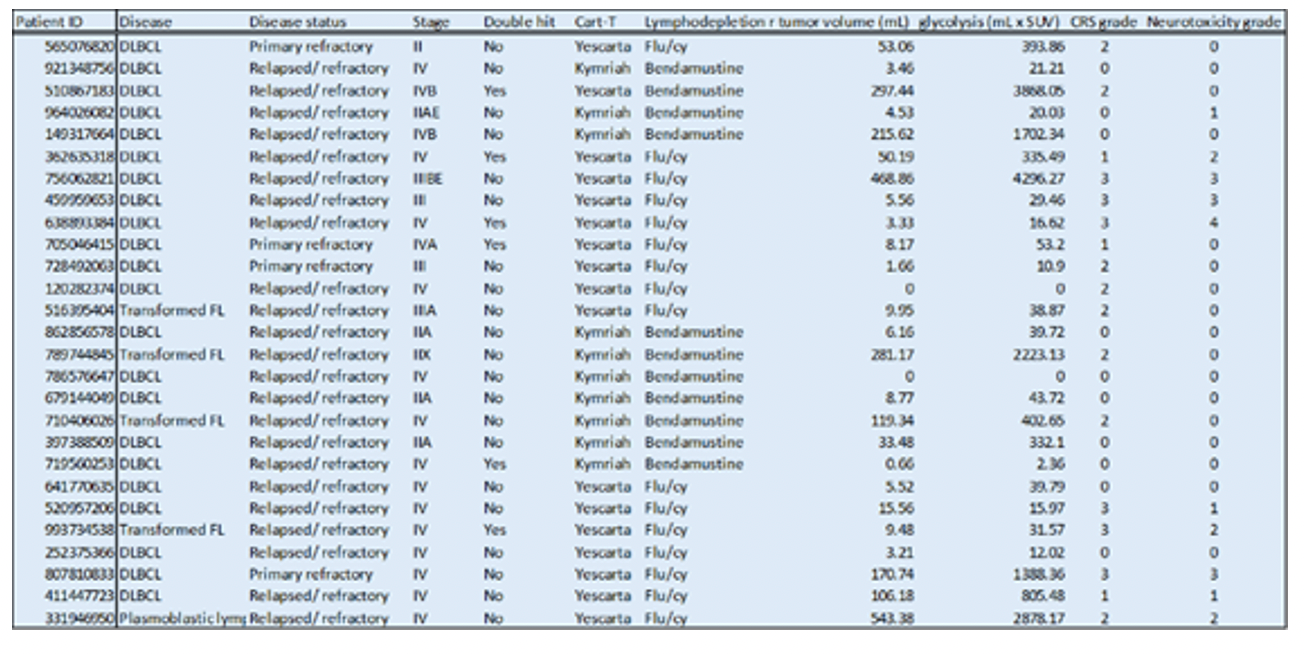
Just like an actual clinical trial, these individual patient data need further analysis. The source data, either from individual records or in aggregate format, does not impact our conclusions, as long as the data context can be clearly explained.
Because of the sample size (392 patients), and the diversified geographic distribution of these patients by institution and by country, plus the large number of unique investigators involved in contributing to the source data utilized in this analysis, we predict with a high level of confidence, that our conclusion showing a reduction in CRS Grades from treatment will be validated by actual single or multiple arm clinical trials on CRS following CAR-T cell treatment.
If discussed early in the clinical trial lifecycle, this approach could be accepted by regulatory authorities as a digital trial arm. Since not all the patients in a digital twin of baseline characteristics have the same efficacy and safety outcome measure(s), and/or the same level of detail on these measures, it is expected that the number of patients in an “efficacy digital twin” and a “safety digital twin” are smaller than those in baseline patient characteristics.
Conclusion
The opportunities afforded by using existing clinical data to accelerate drug development are significant. The ability to predictively model patient safety and efficacy outcomes using contextualized historical patient and cohort level data can be used to profile patient attributes that in turn can successfully support program and trial design and reduce the number of patients that would otherwise be treated in a traditional clinical trial setting. The analysis presented demonstrates the ability to conduct robust retrospective and prospective analyses of drug interventions on patient disease and provides an objective method upon which to accelerate the development of new therapies, reducing patient and physician burden, whilst preserving drug development standards.

Gen Li, PhD, MBA, Phesi, East Lyme, Connecticut, United States, Jonathan Peachey, Phesi, East Lyme, Connecticut, United States, Paul Chew, MD, Phesi, East Lyme, Connecticut, United States, and Peter M. O’Neill, Cellectis, New York, NY, United States
Corresponding author: Gen Li, PhD, MBA, PO Box 82, East Lyme, CT 06333, United States, gen.li@phesi.com
References
- FDA, September 2022, https://www.fda.gov/regulatory-information/search-fda-guidance-documents/clinical-decision-support-software&sa=D&source=docs&ust=1675424773302425&usg=AOvVaw0JBz3-Sd17alQJXO7vAO5L
- Gen Li, et al. Phesi Report: Assessing Single Patient Investigator Sites in Cancer Clinical Trials. Applied Clinical Trials 2022 Jan
- Bianca Santomasso, et al. The Other Side of CAR-T-Cell Therapy: Cytokine Release Syndrome, Neurologic Toxicity, and Financial Burden. Am Soc Clin Oncol Educ Book. 2019 Jan;39:433-444.
- Changjing Cai, et al. A comprehensive analysis of the fatal toxic effects associated with CD19 CAR-T cell therapy. Aging. 2020. 12 (18):18741-18753.
- Inmaculada Hernandez, et al. Total Costs of Chimeric Antigen Receptor T-Cell Immunotherapy. JAMA Oncol. 2018 Jul 1;4(7):994-996.
- Stephanie Si, et al. Spotlight on Tocilizumab in the Treatment of CAR-T-Cell-Induced Cytokine Release Syndrome: Clinical Evidence to Date. Ther Clin Risk Manag. 2020; 16: 705–714.
- Lee, D.W., Santomasso, B.D., Locke, F.L., Ghobadi, A., Turtle, C.J., Brudno, J.N., Maus, M.V., Park, J.H., Mead, E., Pavletic, S., et al. (2019). ASTCT Consensus Grading for Cytokine Release Syndrome and Neurologic Toxicity Associated with Immune Effector Cells. Biol. Blood Marrow Transplant. 25, 625–638.
- Allison Grana, et al. Safety of Axicabtagene Ciloleucel for the Treatment of Relapsed or Refractory Large B-Cell Lymphoma. Clin Lymphoma Myeloma Leuk. 2021 Apr;21(4):238-245.
- John H Baird, et al. Immune reconstitution and infectious complications following axicabtagene ciloleucel therapy for large B-cell lymphoma. Blood Adv. 2021 Jan 12;5(1):143-155.
- Megan Melody et al. Impact of hypoalbuminemia on the prognosis of relapsed/refractory B-cell lymphoma treated with axicabtagene ciloleucel. Eur J Haematol. 2021 Jul;107(1):48-53.
- Sarju Ganatra, et al. Chimeric Antigen Receptor T-Cell Therapy-Associated Cardiomyopathy in Patients With Refractory or Relapsed Non-Hodgkin Lymphoma. Circulation. 2020 Oct 27;142(17):1687-1690.
- Boris Fehse, et al. Digital PCR Assays for Precise Quantification of CD19-CAR-T Cells after Treatment with Axicabtagene Ciloleucel. Mol Ther Methods Clin Dev. 2020 Jan 15;16:172-178.
- Thomas Mika, et al. Digital-Droplet PCR for Quantification of CD19-Directed CAR-T-Cells. Front Mol Biosci. 2020 May 15;7:84.
- Christopher M Wright, et al. Bridging Radiation Therapy Before Commercial Chimeric Antigen Receptor T-Cell Therapy for Relapsed or Refractory Aggressive B-Cell Lymphoma. Int J Radiat Oncol Biol Phys. 2020 Sep 1;108(1):178-188.
Beyond the Molecule: How Human-Centered Design Unlocks AI's Promise in Pharma
June 23rd 2025How human-centered AI that is focused on customer, user, and employee experience can drive real transformation in clinical trials and beyond by aligning intelligent technologies with the people who use them.